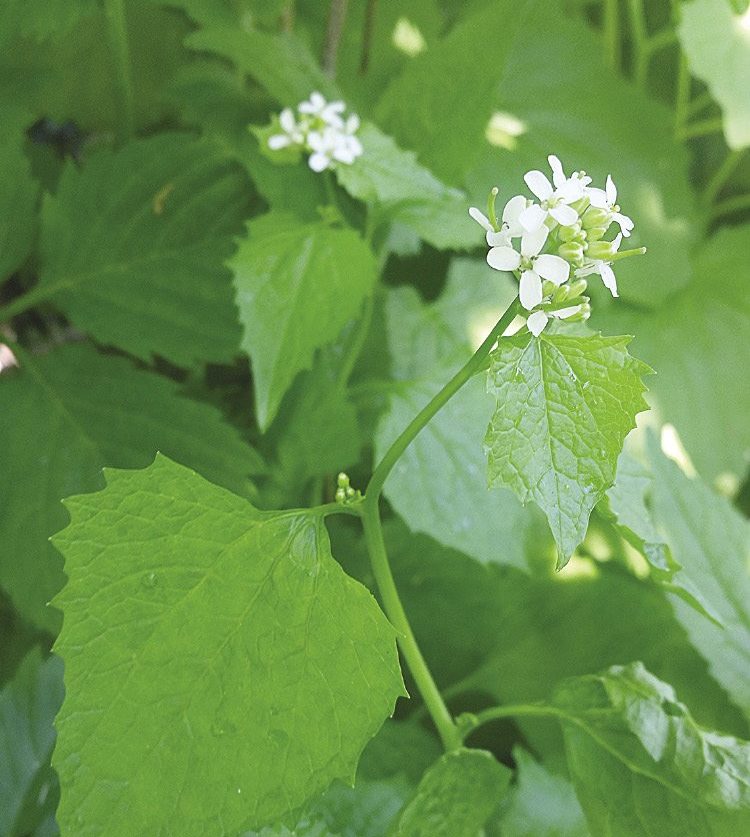If you enjoy the taste of bitter, pungent foods, then garlic mustard may be a healthy and eco-conscious addition to your diet.
As one of the oldest herbs used in Europe, Alliaria petiolata was introduced to North America in the 1800s and has spread widely throughout the continent.
Regarded as an herbaceous weed, it thrives where humans live and travel, with an estimated range across southern Canada and much of the United States with the exception of the Midwest prairies and its southern deserts. On its own it moves very slowly, but with the help of passing animals and humans, it hitches a ride on shoes, animal fur and paws, car tires and bicycles, and creeps a little further each season. It is commonly found in shaded areas, particularly soft forest floors, roadsides, flood plains and trail sides. It will even grow in open fields.
As a member of the mustard family, this aromatic plant is impressively nutritious, out-competing spinach, broccoli leaves, collards, turnip greens, kale and domestic mustard for vitamin C, vitamin E, fiber and zinc content. It is also high in omega-3 fatty acids, calcium, iron and manganese, according to John Kallas, a botanist with a Ph. D in nutrition who’s been teaching and writing about wild food plants since the 1970s.
“Garlic mustard is one of the most nutritious leafy greens ever analyzed,” he writes in his book, Edible Wild Plants.
Apart from its attractive nutrition profile, there are some ecologically sound reasons to eat garlic mustard—about as much as your heart desires.
Like most invasive species, garlic mustard does not have any significant natural predators to control its populations in North America. What’s more, its roots release chemicals that kill beneficial mycorrhiza—underground fungi that support many native plants—and inhibit them from growing. In a relatively short time span, woodland areas can be completely overrun by garlic mustard if left unchecked.
How to Identify Garlic Mustard
Garlic mustard is an early springtime green and usually crops up around the same time as stinging nettles. The leaves vary from rounded at the base, to kidney-shaped, to triangular at the top of the plant with a slightly serrated edge. Venations, or lines along the leaves, is pronounced and the foliage is generally a rich, deep shade of green.
It starts out as a small, squat herb on the forest floor, but as temperatures warm the plant sends up a flower stem that grows to about three feet fall. Clusters of small white flowers emerge, and the stem eventually forms a seedpod.
With few plants that closely resemble garlic mustard, most foragers can be confident after it has been positively identified. Like many plants, you are likely to develop an eye for garlic mustard and recognize it everywhere you go thereafter.
If you’re in doubt, crush a couple of leaves in your hand. If they smell like garlic, then you’ve found what you’re looking for. Instead of cutting the plant at the base (unless you have a small patch and want to continue harvesting), you can dig or pull it up by its roots to help control its spread.
Recipes
I happen to really enjoy bitter greens and vegetables in the brassica family, so I don’t go to great lengths to disguise garlic mustard’s flavour. I usually chop up young stems and leaves and wilt them as I would with spinach, or sauté with a bit of oil, then add them to scrambled eggs. I’ve even added a handful on top of a burger or sandwich in place of lettuce. But for more calculated recipes, here are a couple with a short list of ingredients. Experiment by adding your own preferences of herbs and spices to really make these recipes sing. Enjoy!
Beans with Garlic Mustard
From John Kallas, Edible Wild Plants
This is a simple cold plate recipe. Serves 4.
- 2 cups of drained and rinsed canned red kidney beans
- 1/2 cup chopped garlic mustard leaves
- 1/3 cup raisins
- 2 tablespoons extra virgin olive oil
- 2 tablespoons balsamic vinegar
- Salt and pepper to taste
Mix all ingredients – no cooking required.
Garlic Mustard Pesto
Adapted from FarmSteady in Brooklyn, New York
Great on pasta, toast and as a rub on anything headed for the grill.
- 2 cups garlic mustard leaves
- 1/4 cup pine nuts or walnut pieces
- 2 cloves garlic
- 1/2 cup olive oil
- 1/2 cup pecorino, Romano or parmesan cheese, grated
Blend in a food processor until smooth. Using a spatula, fill a small glass jar and keep refrigerated.




